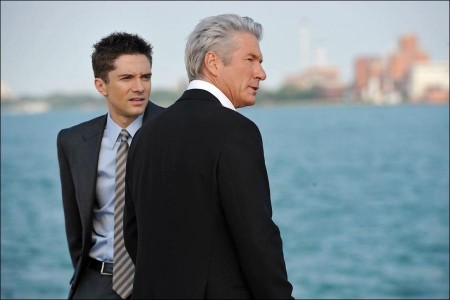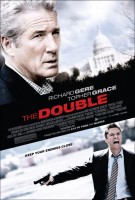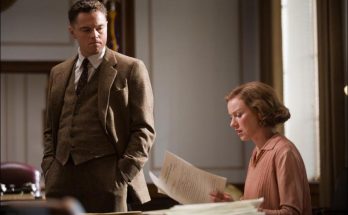Taglines: Keep your enemies close.
The mysterious murder of a US senator bearing the distinctive trademark of the legendary Soviet assassin Cassius, forces Paul Shepherdson (Richard Gere), a retired CIA operative, to team with rookie FBI agent, Ben Geary (Topher Grace), to solve the crime.
Having spent his career chasing Cassius, Shepherdson is convinced his nemesis is long dead, but is pushed to take on the case by his former supervisor, Tom Highland (Martin Sheen). Meanwhile, Agent Geary, who wrote his Master’s thesis on Shepherdson’s pursuit of the Soviet killer, is certain that Cassius has resurfaced. As Shepherdson and Geary work their way through crimes both past and present, they discover that Cassius may not be the person they always thought him to be, forcing both to re-examine everything and everyone around them.
About the Production
A cunning film of deception and pursuit, THE DOUBLE marks a welcome return for the classic espionage thriller – reviving a genre both known and loved for its cat-and- mouse construction and double and triple crosses, while providing some contemporary twists and turns of its own. Directed by Michael Brandt from an original screenplay he wrote with his longtime partner Derek Haas, the film is set in the still-murky waters of international intrigue where American agents (double and otherwise) chase elusive Russian spies who walk among us undetected.
Starring Richard Gere and Topher Grace as a pair of mismatched US operatives on the hunt for a notorious assassin known as “Cassius,” THE DOUBLE proves that, though the Cold War is long over, and the Soviet Union is a thing of the past, such timeless genre trappings as moles, sleepers, code names, and nefarious deeds done in the name of national security never go out of style.

In THE DOUBLE, Gere stars as Paul Shepherdson, a retired CIA agent who spent the better part of his career pursuing the fabled Cassius. When a US Senator is brutally murdered right under the nose of the Secret Service, the daring of the crime and the choice of weapon – a garrote – bear Cassius’ unmistakable signature, even though Shepherdson swears the Russian killer is long since dead. FBI rookie, Ben Geary (Grace) did his thesis on the Shepherdson/Cassius case, and is convinced that this new murder is not a copycat and that Cassius himself is back in action. Despite the elder agent’s reluctance, the pair must team to make sure Cassius is stopped once and for all. What we soon learn – and what Geary must never learn – is that Shepherdson is a double agent; in fact, his well-kept secret for nearly two decades is that he is Cassius.
“When I first read THE DOUBLE it reminded me of classic thrillers that I always enjoyed like THREE DAYS OF THE CONDOR and THE DAY OF THE JACKAL,” says producer Ashok Amritraj. “Like with those great movies, this film maintains its timelessness as it deals with threats that are ever present in our lives and keeps us in constant suspense.”
Wondering how Shepherdson conducts a credible investigation while still keeping his partner off the scent, or whether Geary will discover that the man he works alongside is the very killer he is trying to capture or, most importantly, whether Brandt and Haas are tricking us the way their characters trick each other, is where the suspense – and the fun – of THE DOUBLE lies.
“We’ve always been huge fans of Ludlum and Clancy,” confesses co-scenarist/producer Derek Haas, in explaining why he and his partner, Michael Brandt, were drawn to the ‘spy thriller’ genre. As he points out, “an enemy walking amongst us fosters great subject matter. Brandt adds, “I’ve always been interested in stories with twists and turns, where characters have to think on their feet and live in a morally ambiguous world that we, as common folk, don’t understand. When I was thirteen,” he continues, “I picked up my mom’s copy of ‘All the President’s Men’ and read it twice in a row. I didn’t understand much of it, but was fascinated that such a world and people like that could exist. The issue of ‘trust’ in a movie, where character relationships are on tenuous ground, is exciting to me as a fan and as a filmmaker.”
Though longstanding fans of the genre – “we’re huge fans of films like ‘Patriot Games,’ and we certainly honor them in our film,” admits Haas – both he and Brandt are aware that the espionage thriller stopped being a staple of Hollywood cinema after glasnost and perestroika “humanized” our Soviet “enemies.” Then, when the Soviet Union came undone, the whole concept of an enemy against whom America had to defend itself changed, and the threats emanating from the Middle East began to dominate our thrillers. Haas observes, “For a while, everyone rallied around terrorism as the common enemy, and the espionage thriller took on this bent to reflect what was going on in the world. But, audiences grew bored with cookie-cutter, radical, theocratic bad guys.” Brandt observes that, “a standard of the spy genre is ‘infiltration,’ and that’s hard to pull off when dealing with a Middle Eastern country.”
As to why they feel the “classic spy thriller” has rebounded – and why they wanted to be in the vanguard of its renaissance – Haas notes, “news broke about the covert Russian spies discovered in the U.S. and Britain. Suddenly, the mystery, interest, and anxiety about a new Cold War became fresh and original again.” Brandt adds, “Russia’s resurgence helps make movies like ours credible.”
That said, the filmmakers knew that even though the cold war was ‘hot’ again, they couldn’t just recreate the genre as it existed in its late 20 th Century heyday. As Haas observes, “I think there’s a lot of uncertainty in the world about what Russia is up to right now. Before, you could do a movie with a Cold War setting and it was easy to tell right from wrong. Now, the lines are much more hazy, and we had to play off of that uncertainty and ambiguity.” Brandt concurs, adding that since, “the lines aren’t as defined as they once were politically, the storytelling today should embrace that. There’s a little more legwork that needs to be done today if a filmmaker wants to capture the zeitgeist.”
This moral “haziness” that Haas refers to is reflected in the film’s protagonists, played by Gere and Grace. As they did in their highly regarded screenplays to “3:10 to Yuma” and “Wanted,” the writers systematically blur the conventional boundaries between the ‘good guy’ and the ‘bad guy,’ with each moving closer to a moral middle ground as the story unfolds. Haas says, “We are always interested in complex male relationships – fathers and sons, outlaws and lawmen, or brothers.
In THE DOUBLE, we loved the idea of a retired CIA officer, a guy who has always done his job on his own terms, having to pair up with a young FBI agent. Would they learn from each other, or try to destroy each other? The best characters are rendered in shades of gray, and we try to do that here.” Brandt adds that they wanted to “make their protagonists as interesting as their antagonists, to the point where the Shepherdson character is actually both. “In the 80s,” he observes, “Hollywood made a living out of good guys who had quippy one-liners and bad guys whose sole purpose was to die at the end. Ultimately, there’s nothing satisfying to us about that. If you can keep an audience unsure as to whom it owes its allegiance, it’s way more engaging.”
A cornerstone in their strategy to destabilize the audience is to reveal relatively early the fact that Gere’s character is not at all who and what we thought he was – the sort of “plot twist” that might normally come at the climax of a conventionally plotted thriller. But, as Haas emphasizes, “we titled the movie THE DOUBLE and put Richard Gere’s face on it. We believed audiences would walk into the movie already trying to figure out ‘the twist,’ so we dash those expectations, (or affirm them), in the first thirty minutes. The idea is to make them wonder, ‘okay, now what can I expect?’ We like to keep audiences guessing.” Brandt adds that, “At its core, the movie is about a double agent who is after himself. Keeping that detail from audiences erases everything the film is about. The bigger risk to us is having the audience know more than Topher Grace does for a good part of the movie. Ultimately, we embraced that because we wanted to see Richard Gere figure out how to get out of the maze we tossed him into.”
The main plot mechanism – having two agents pursue a culprit when we know that one of them is the very culprit in question – was inspired, as Brandt tells us, “by a lifetime of watching spy movies and reading spy novels. The idea of a ‘double’ agent naturally allows for truths and untruths. We wanted to get into what happens when someone who has spent a lifetime living those untruths tries to get out.” Haas adds that he and Brandt drew inspiration from films like “No Way Out,” another example of a thriller in which the antagonist everyone is looking for turns out to be the protagonist. “That film, and “Three Days of the Condor’ tighten the net around the protagonist, and the fun was in the audience asking, ‘How is he going to get out of this one?’ We thought it would be a very interesting noose to put around the character’s neck, and still have a mystery extending throughout. Then, to top it off, our loyalty shifts, and we start to ask, Will he kill this young FBI agent as he gets closer to the truth?’ It’s fun for us to watch that shift take place.”
The filmmakers were mindful of the fact that this kind of morally ambiguous, even corrupt, character plays to Richard Gere’s strengths as an actor. “Two of our favorite Richard Gere films,” says Haas, “are ‘Internal Affairs’ and ‘American Gigolo,’ in which he was always so damned cool and disconcerting. In the movie, Martin Sheen says, ‘Its Cassius…he’s back.’ We always thought that worked two ways, because Richard is ‘back’ with this film…in that bad-ass, cool, stealthy, unhinged manner that he portrays so well. I think audiences who loved him in those films are going to be excited to watch him in this one.” Brandt adds that, “Richard is that rare actor who, when he’s ‘bad,’ you still like him and root for him to be even ‘badder.’ His intensity and focus come through in everything he does in front of the camera, and every choice he makes is authentic.”
Though creating an espionage thriller for the 21 st Century, Brandt honors the long legacy of the genre. “As a director,” he says, “I wanted to make a movie that had some dirt in its cracks. The grainy, textural movies of the ‘70s, like ‘Three Days of the Condor’ and ‘The Parallax View,” were visual inspirations. The great Jeffrey Kimball (‘Top Gun’, ‘True Romance’, ‘The Expendables’) was our D.P., and we shot the film with lots of longer lenses to get that very feel. Long lenses create a sense of surveillance and energy, which we use more as the movie progresses.” Haas sums it up by noting that these and “a hundred more spy films paved the way for THE DOUBLE.”
Despite their many efforts to modernize the genre to suit today’s climate, the filmmakers maintain that they have a sense of nostalgia for the Cold War and the kind of classic spy thrillers made in that era. “When those stories work,” says has, “they’re brilliant.” Brandt concludes by saying that he feels not only nostalgia for that era, but also envy. “Two spies meeting on a bridge in Prague in 1980 was such a simple idea that could go in a hundred different directions. Once you add cell phones, satellites, and whatever new technology exists to the mix, the simplicity of those old spy stories is kind of lost. Now, we have to come up with reasons why a guy doesn’t just pick up his phone and call in a drone strike!”
The Double
Directed by: Michael Brandt
Starring: Richard Gere, Topher Grace, Martin Sheen, Odette Annable, Stephen Moyer, Stana Katic, Yuri Sardarov
Screenplay by: Michael Brandt, Derek Haas
Production Design by: Giles Masters
Cinematography by: Jeffrey L. Kimball
Film Editing by: Steve Mirkovich
Costume Design by: Aggie Guerard Rodgers
Set Decoration by: Daniel Bahorski, Erin Boyd, Dajuan Lawson
Art Direction by: Caty Maxey
MPAA Rating: PG-13 for intense sequences of action and violence, some disturbing images and language.
Studio: Image Entertainment, Universal Pictures
Release Date: October 28, 2011
Hits: 54




